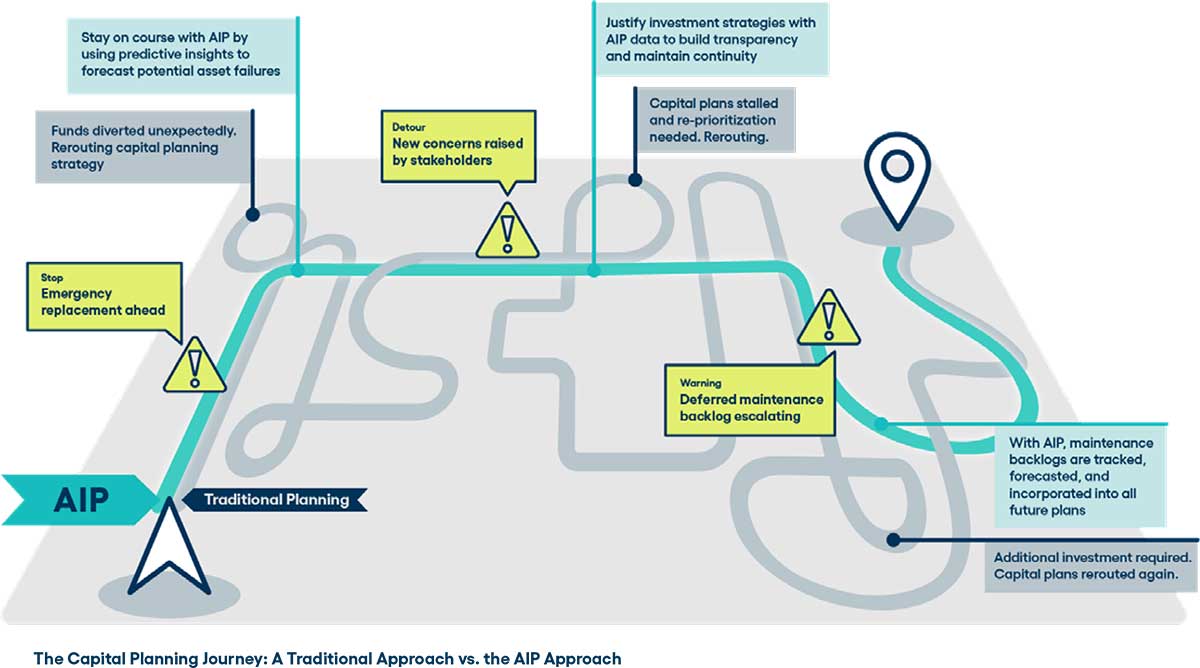SPONSORED
Brightly - Branded Feature
Modernizing Capital Planning: How AIP Bridges the Gap Between Facilities and Finance

Strategic capital planning is the cornerstone of effective sustainable asset management. But for many organizations, funding and investment plans are determined based on a series of isolated decisions rather than a collaborative strategy. When finance and facilities teams work in silos, the result is often fragmented planning that misses out on potential opportunities for improved efficiency, cost savings, and longer-term success.
Truly effective capital planning requires teamwork, data sharing, and alignment to ensure investments are made with the full picture in mind. This is where Asset Investment Planning (AIP) can help.
AIP provides a modern and elevated approach to capital planning, shifting it from a one-time exercise into an ongoing strategy that leverages insights across your organization. In many ways, traditional capital planning is like a paper map for your organizational journey, that provides direction on a general route with key stops along the way. You know where you want to go. You can include various insights and data points that will help you plan to get there. But there isn’t much room for flexibility and roadblocks along the way will require a reactive approach to when they’re reached.

McLaren Health used AIP analytics to maximize funding for facilities investments
McLaren Health Care in Grand Blanc, MI is a fully integrated healthcare delivery system made up of 12 hospitals, ambulatory surgery centers, and imaging centers. In the past, McLaren’s facilities team had struggled to gain a clear understanding of their complete capital needs across their facilities.
In 2021, McLaren began using Brightly’s AIP software that was able to integrate with their existing CMMS. With the new software, their team was instantly able to better understand their capital, deferred capital, and future needs. The advanced reporting capabilities also made it easier to present clear and transparent data to their capital committee when requesting additional funding.

“It allows us to maintain visibility of our needs and continually make adjustments… in the past, it was hard to get capital dollars. Now that we have data and proof of what we need, people trust our data, give us the funding we need, and allow us to do what we need for capital improvements.”
— Keith Miller — Corporate Director of Facilities and Energy, McLaren Health
With detailed asset analytics from their AIP software, the McLaren Health facilities team was able to secure 25% more annual capital funding from their finance department and continues to consistently achieve their annual cost reduction goals. You can learn more about how McLaren Health Care revolutionized their facilities management and capital planning with AIP by reading the full story here.
Driving objective decision-making with AIP
In many organizations, finance and facilities teams have traditionally operated independently of one another, each with their own unique priorities and processes. While this division might seem necessary to ensure control and accountability, it often leads to fragmented decision-making that overlooks the bigger picture.
Take for example a facilities manager at a public school district who creates a capital plan that addresses the needs of their schools for the next 3-10 years. If this plan doesn’t take into account factors like anticipated city growth or community needs, it could ultimately become a hindrance on future development and require a complete shift in strategy down the line. The value of every department’s input is essential, but relying on insights in silos leads to misallocated resources and missed opportunities for broader improvements.

The power of AIP lies in its ability to provide objective insights based on real-time, actionable data from all available sources. Instead of relying on disparate feedback, organizations can make decisions grounded in facts, metrics, and forecasts, even using data to model multiple funding scenarios to find the most effective path forward.
Whether its deciding to replace an aging HVAC system or planning for long-term infrastructure improvements, AIP ensures that all decisions are well-supported by data and inclusive of all stakeholder feedback. This shift from fragmented, reactive decision-making to a collaborative, proactive approach is the key to optimizing asset management and maximizing long-term value.
The Benefits of AIP
Asset investment planning offers several key benefits that go beyond simply improving capital planning; it can enhance efficiency, improve transparency and trust, optimize resource allocation, and more.
- Enhance prioritization based on your most critical needs
AIP helps organizations prioritize asset investments by analyzing performance data to identify which assets are critical to operations, safety, and long-term sustainability. By considering factors like asset condition, expected life, and business impact, AIP ensures that limited resources are directed toward the most urgent needs, minimizing downtime, reducing costs, and mitigating safety risks.
- Forecast outcomes by modeling funding scenarios
AIP allows organizations to model multiple funding scenarios, providing valuable insight into the financial impacts of different investment strategies. This feature enables finance and facilities teams to collaborate, balance immediate needs with future growth, and adapt strategies to overcome funding shortages, ensuring that critical projects are not delayed due to unexpected financial constraints.
- Align priorities across departments to improve transparency and accountability
By centralizing asset data, AIP fosters collaboration between finance, operations, compliance, sustainability, and facilities teams, ensuring that all departments are aligned around common goals. This transparency enhances decision-making and accountability, allowing teams to justify investments, track progress, and ensure that capital plans align with organizational objectives.
- Optimize resource allocation and reduce waste
AIP improves resource allocation by using real-time data and predictive analytics to direct investments toward high-impact areas. By identifying underutilized assets and forecasting future needs, AIP helps organizations reduce waste, avoid over-investing in non-priority areas, and improve overall efficiency in capital planning and operational performance.
- Improve asset resiliency and reliability through predictive maintenance
AIP uses predictive analytics to anticipate when assets will require maintenance or fail, allowing organizations to take proactive steps to prevent costly downtime and repairs. This shift from reactive to proactive maintenance not only extends asset life but also enhances operational reliability, ensuring assets remain resilient and reliable over time.
Oneida County, NY is using AIP to create a more connected future
Oneida County is made up of 26 towns in the state of New York and is home to more than 230,000 residents. The county has 120 public works staff members across three divisions: Engineering, Buildings & Grounds, and Highways, Bridges, & Structures. In the past, the county had fully relied on its CMMS data to improve efficiency, before realizing the potential of adding on AIP software.
With Brightly’s CMMS, Oneida County was able to resolve several inefficiencies, like only scheduling deliveries to certain parts of the county on certain days of the week to reduce fuel waste and save drivers time. This helped improve efficiency and lower costs, while adding more predictability to their workers’ schedules.
In addition to improved savings, the software allowed Oneida to centralize technician data from across the country and boost visibility across sites to more easily see the tasks and procedures handled by each employee. Now when maintenance or task data is entered into their system, the county can keep that knowledge and allow for improved cross-training when needed.
“We encourage employees to include as much information as possible about what they do. It’s really created a better team atmosphere because everyone’s working together instead of just doing their own thing.”
— Matthew Baisley &mdah; Commissioner of Public Works, Oneida County
Now the county is set to implement AIP software from Brightly to better forecast future needs of their public works divisions, with one of their first projects being to “right size their fleet.” The county expects that using AIP to analyze their CMMS data and provide detailed insights will make developing capital plans and funding requests easier for the future. To learn more about how Oneida County is creating a more data-led future, you can read their full story here.
AIP is a game-changer for modern capital planning
Asset Investment Planning is more than just a tool for managing capital. It’s the key to unlocking smarter, data-driven decision-making across your organization. By aligning finance, facilities, and other departments around a shared, comprehensive view of asset data and facility health, AIP ensures that capital investments are made with the full scope of your business’ and community needs in mind.
Whether you’re navigating budget constraints, managing aging assets, or planning for growth, AIP equips you with the tools needed to make better decisions for your organization’s long-term success. Learn more about ways to modernize your capital planning and discover how AIP can work for your organization. Read our guide: “Strategic Guidance for Elevating and Modernizing Your Capital Plans.”
Brightly Software, a Siemens company, enables organizations to manage the entire lifecycle of their assets, facilities and infrastructure. As the global leader in intelligent asset management solutions for more than 25 years, Brightly’s sophisticated cloud-based platform is expertly designed to improve capital planning through smarter, data-driven decision making, empower technicians to predict, prioritize and manage preventative maintenance activities, and support organizations to achieve sustainability, compliance and efficiency goals.
Learn more at
brightlysoftware.com











